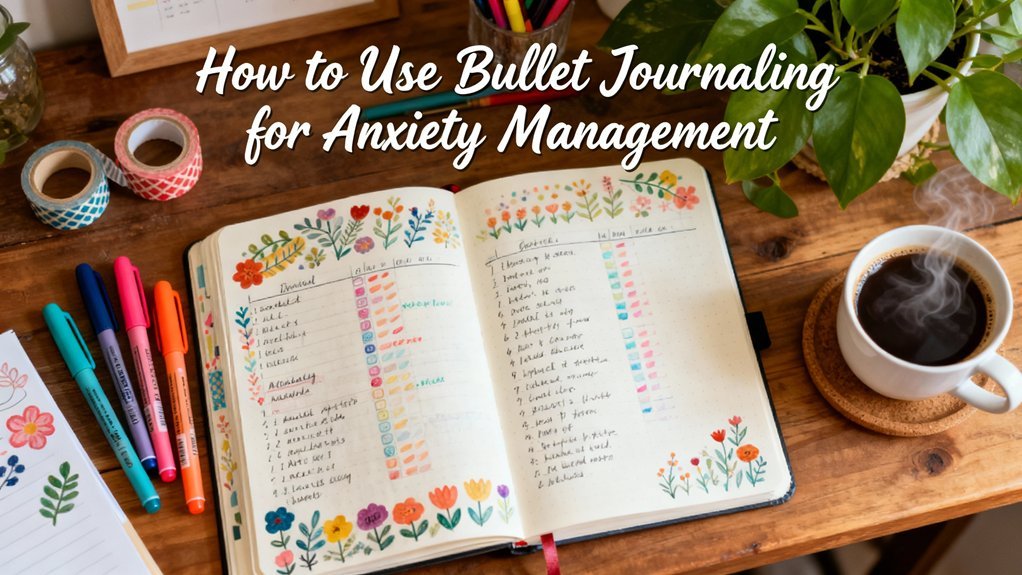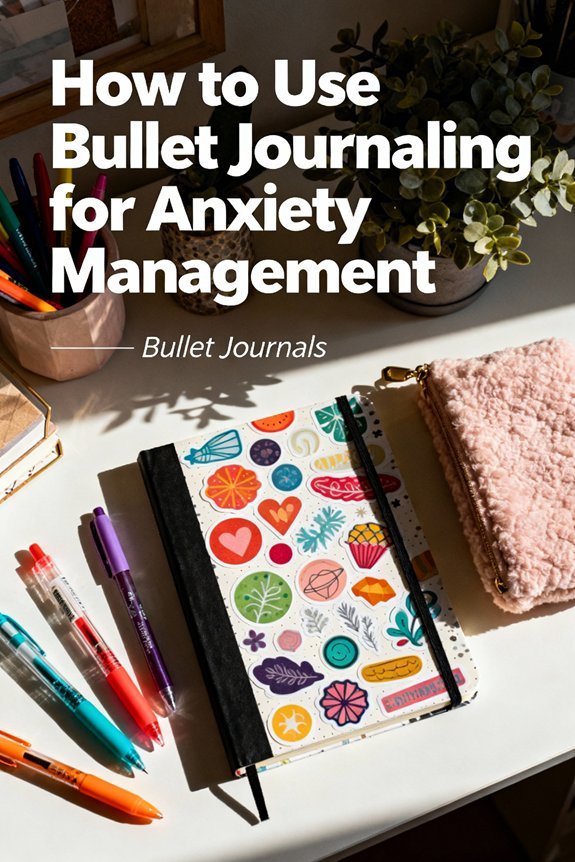You can use bullet journaling to manage anxiety by externalizing intrusive thoughts through rapid logging, which activates your parasympathetic nervous system and interrupts rumination cycles. Start with a dot-grid notebook and create brain dump pages to offload cognitive overload, then design evidence-based trackers that monitor physiological symptoms, cognitive distortions, and behavioral patterns using gradient scales. Anchor your practice to existing routines, track triggers and coping mechanisms through collections, and incorporate structured gratitude prompts to reframe neural pathways. The extensive approach below alters subjective anxiety into quantifiable data for targeted intervention.
Key Takeaways
- Bullet journaling interrupts anxiety by externalizing worries through structured documentation, activating the parasympathetic nervous system to counteract hyperarousal.
- Brain dump pages transform intrusive thoughts into manageable data points, reducing rumination when performed every 72 hours or during acute episodes.
- Anxiety trackers should measure physiological symptoms, cognitive distortions, and behavioral responses using gradient scales to reveal symptom patterns over time.
- Anchor journaling to existing routines and keep supplies visible to minimize effort, aiming for 66 consecutive days to establish automaticity.
- Adapt tracking methods as symptoms evolve, shifting focus from acute monitoring to rumination interruption and social engagement documentation.
Understanding the Connection Between Bullet Journaling and Anxiety Relief

When individuals experience anxiety, their autonomic nervous system activates the fight-or-flight response, flooding the body with cortisol and adrenaline while impairing prefrontal cortex function. Bullet journaling interrupts this cascade through structured externalization of cognitive load.
You'll find that systematic documentation activates your parasympathetic nervous system, counteracting hyperarousal states. The method's rapid logging technique reduces rumination by converting abstract worries into concrete, actionable data points. This cognitive offloading decreases working memory demands while improving executive function.
Research demonstrates that journaling benefits extend beyond mere catharsis. The practice supports emotional regulation through repeated exposure to distressing stimuli in a controlled format.
When you integrate mindfulness practices into your bullet journal framework, you're effectively creating a portable biofeedback mechanism.
Bullet journaling combined with mindfulness transforms your notebook into a biofeedback device, enabling real-time self-regulation wherever you are.
The combination produces measurable outcomes: decreased baseline cortisol levels, improved HRV (heart rate variability), and increased metacognitive awareness.
You're not simply tracking symptoms—you're rewiring neural pathways through deliberate, repetitive documentation protocols.
Essential Supplies and Setup for Your Anxiety Management Journal
The neurophysiological benefits of bullet journaling require minimal equipment, though specific materials improve therapeutic outcomes. Your anxiety management tools should prioritize tactile engagement and cognitive accessibility rather than aesthetic complexity.
Core Bullet Journal Supplies for Clinical Applications:
- Dot-grid notebook (A5 format) – Provides spatial organization without visual overwhelm, facilitating structured thought patterns and reducing decision fatigue.
- Fine-point pens (0.5mm) – Enable precise motor control, activating prefrontal cortex regions associated with emotional regulation.
- Color-coding system (3-4 markers) – Supports rapid cognitive categorization of anxiety triggers, coping mechanisms, and symptom tracking.
You'll refine neuroplastic adaptation by maintaining consistent supplies throughout your practice. This eliminates cognitive load from material variables and directs attentional resources toward therapeutic processing.
Innovation emerges not from complex bullet journal supplies but from systematic implementation of evidence-based tracking protocols that change subjective anxiety experiences into quantifiable, actionable data. Additional journaling accessories like stickers and printable spreads can enhance your practice once foundational techniques are established, making the therapeutic process more engaging without compromising clinical effectiveness.
Creating Brain Dump Pages to Declutter Your Mind

Brain dumping is a cognitive offloading technique that conveys intrusive thoughts and worries from working memory onto paper, reducing mental load and rumination patterns commonly associated with anxiety disorders.
You'll need to establish specific triggers for initiating a brain dump session—whether scheduled daily, symptom-triggered during acute anxiety episodes, or situational when facing overwhelming cognitive demands.
Once you've externalized these thoughts, you can categorize and prioritize the content using structured organizational methods that convert chaotic mental clutter into actionable items, deferred concerns, or thoughts requiring further clinical examination.
What Is Brain Dumping?
Cognitive overflow occurs when intrusive thoughts, worries, and mental tasks accumulate beyond your working memory capacity, exacerbating anxiety symptoms and impairing executive function.
Brain dumping systematically externalizes this cognitive load through rapid, unfiltered transcription of mental content onto paper. This evidence-based intervention utilizes effective journaling to reduce rumination patterns and restore cognitive bandwidth.
Brain dump techniques aid anxiety management through three primary mechanisms:
- Neural offloading: Transferring internal mental representations to external storage reduces working memory burden.
- Pattern recognition: Written documentation reveals recurring anxiety triggers and maladaptive thought cycles.
- Cognitive restructuring: Visualization of thoughts enables objective analysis and reframing.
You'll experience immediate anxiety reduction as scattered mental fragments change into manageable, concrete data points ready for systematic processing and prioritization.
When to Dump Thoughts
Timing your brain dumps strategically enhances their therapeutic efficacy for anxiety regulation.
You'll achieve maximum emotional release by implementing thought timing protocols during peak rumination periods—typically morning awakening, pre-sleep, or following triggering events. Research indicates that immediate cognitive offloading prevents maladaptive thought spiraling and reduces cortisol increase.
Schedule structured dumps during your circadian vulnerability windows when intrusive thoughts intensify. You can also utilize spontaneous dumps when experiencing acute anxiety symptoms, cognitive overload, or decision paralysis.
This dual-approach methodology addresses both predictable and unpredictable anxiety manifestations.
Consider establishing predetermined intervals—every 72 hours minimum—to prevent cognitive accumulation. Advanced practitioners integrate physiological cues: heightened heart rate, muscle tension, or concentration deficits signal prime dumping moments.
This responsive framework changes brain dumping from reactive coping into proactive anxiety architecture.
Organizing Your Dumped Content
Raw, unstructured thought output requires systematic categorization to convert chaotic mental debris into actionable anxiety-reduction data. Your page layout should aid content categorization through distinct visual aesthetics that improve mental clarity while promoting journaling consistency.
Implement this evidence-based organizational framework:
- Thematic Clustering: Group related anxieties by domain (interpersonal, occupational, physiological) to identify pattern-based triggers requiring intervention.
- Priority Stratification: Rank dumped content using urgency metrics that inform time management decisions and resource allocation.
- Action Translation: Alter abstract worries into concrete behavioral tasks that enable creative expression and stress relief.
This structured approach converts cognitive overwhelm into manageable components, establishing neural pathways between chaotic ideation and systematic problem-solving.
Your organizational methodology becomes the bridge between emotional turbulence and therapeutic resolution, maximizing innovation in personal anxiety-management protocols. The Bullet Journal Method provides the foundation for this organizational practice by helping you slow down and clear mental clutter so you can reconnect with what truly matters.
Designing Mood and Anxiety Trackers That Actually Work
While traditional mood tracking often fails due to oversimplification of complex emotional states, evidence-based tracker design incorporates specific diagnostic markers that align with DSM-5 anxiety disorder criteria.
You'll need to measure physiological symptoms (heart palpitations, trembling), cognitive distortions (catastrophizing, rumination), and behavioral responses (avoidance patterns, safety-seeking behaviors) simultaneously.
Structure your anxiety patterns monitoring through gradient scales rather than binary inputs. Track intensity (1-10), duration, and contextual triggers within single entries. You're creating longitudinal data that reveals correlations between variables—sleep quality, social interactions, and symptom severity.
Implement temporal mapping by recording symptom onset times, peak intensity windows, and resolution periods. This granular mood tracking exposes circadian patterns and identifies high-risk timeframes.
Include medication timing, exercise duration, and caffeine intake as confounding variables. Your tracker becomes clinically useful when it generates practical insights through systematic observation rather than subjective emotional labeling.
Using Collections to Organize Triggers and Coping Strategies
Collections serve as dedicated pages where you can systematically catalog anxiety triggers and evidence-based coping mechanisms in one accessible location.
Research indicates that identifying specific triggers—environmental, interpersonal, or cognitive—enables you to implement targeted interventions before symptoms escalate.
Tracking Your Anxiety Triggers
Anxiety triggers—those specific situations, thoughts, or stimuli that precipitate acute anxiety responses—require systematic documentation to establish identifiable patterns and develop targeted interventions.
Your bullet journal becomes a diagnostic instrument for trigger identification through structured emotional journaling.
Implement these evidence-based tracking methodologies:
- Contextual documentation: Record temporal data, environmental factors, and physiological symptoms concurrent with anxiety onset.
- Severity quantification: Utilize numerical scales (0-10) to measure intensity, enabling comparative analysis across episodes.
- Pattern correlation: Cross-reference entries to identify recurring themes through stress mapping techniques.
This longitudinal approach alters subjective experiences into objective data sets.
You'll discover anxiety patterns that might otherwise remain obscured, facilitating precision-targeted coping mechanisms.
The resulting insights enable proactive management rather than reactive responses to anxiogenic stimuli.
Building Your Coping Toolkit
The bullet journal collection system alters disparate anxiety management techniques into an organized, retrievable resource through dedicated reference pages.
You'll create indexed collections that catalog evidence-based interventions: grounding exercises, progressive muscle relaxation protocols, and cognitive restructuring templates. Document self care strategies with implementation specificity—duration, frequency, and contextual parameters for ideal efficacy.
Your mindfulness techniques collection should include breath work ratios, body scan sequences, and sensory awareness exercises with measurable outcomes.
Cross-reference these collections with your trigger logs to establish data-driven correlations between specific stressors and effective interventions. This systematic approach converts reactive anxiety responses into proactive management protocols.
You're building a personalized diagnostic tool that evolves with your therapeutic progress, enabling pattern recognition and intervention maximization through longitudinal tracking.
Building Daily and Weekly Spreads for Stress Management

Structured daily and weekly spreads function as cognitive scaffolding that externalizes worry patterns and establishes predictable routines—two evidence-based mechanisms for reducing generalized anxiety symptoms.
Cognitive scaffolding through structured spreads externalizes anxiety patterns while establishing predictable routines that demonstrably reduce generalized worry symptoms.
Your spreads should incorporate behavioral activation principles while tracking autonomic arousal indicators.
Design your daily habits spreads to include:
- Temporal anchoring blocks that segment your day into manageable intervals, preventing cognitive overwhelm through discrete task compartmentalization.
- Somatic symptom trackers monitoring physiological anxiety markers (heart rate variability, muscle tension, sleep latency).
- Cognitive distortion logs identifying catastrophizing patterns and attribution errors in real-time.
Your weekly reflections should synthesize longitudinal data, revealing cyclical stressors and protective factors.
Map anxiety trajectories against environmental triggers, social interactions, and circadian rhythm disruptions. This metacognitive practice strengthens your distress tolerance while building executive functioning capacity.
You'll develop predictive awareness of vulnerability periods, enabling proactive intervention deployment rather than reactive crisis management.
Incorporating Gratitude and Positive Reflection Practices
While tracking anxiety symptoms provides diagnostic clarity, neuroplasticity research demonstrates that deliberate positive affect cultivation creates competing neural pathways that attenuate threat-detection hyperactivity in the amygdala.
You'll improve this mechanism by implementing structured gratitude prompts that target specific domains: relationships, achievements, sensory experiences, and growth opportunities.
Design reflection rituals using evidence-based mindfulness exercises that anchor awareness in present-moment appreciation rather than rumination cycles.
Incorporate joy journaling through systematic documentation of positive experiences, however minor they appear.
Create appreciation lists that identify three distinct elements daily, forcing cognitive reappraisal of neutral or negative situations.
You'll boost efficacy by pairing positive affirmations with physiological data—noting correlations between gratitude practices and reduced heart rate variability or improved sleep metrics.
Time-stamp your entries to establish pattern recognition.
This diagnostic precision reveals which interventions produce measurable anxiety reduction, allowing you to refine your protocol iteratively and develop a personalized, evidence-backed approach.
Making Bullet Journaling a Sustainable Anxiety-Relief Habit

Behavioral psychology confirms that habit formation requires consistent environmental cues, reduced friction points, and immediate reinforcement—principles you'll apply to change sporadic bullet journaling into an automatized anxiety management protocol.
To enhance bullet journal benefits for sustained anxiety relief, implement these evidence-based strategies:
- Anchor journaling to established routines through temporal pairing—attach your practice to existing behaviors like morning coffee or evening medication administration to utilize pre-existing neural pathways.
- Minimize activation energy by maintaining your journal in high-visibility locations with writing instruments attached, eliminating decision fatigue that compromises adherence during acute anxiety episodes.
- Track completion metrics using habit-tracking modules that provide visual reinforcement of consistency, activating dopaminergic reward circuits that strengthen behavioral maintenance.
Research demonstrates that habit automaticity develops after 66 days of consistent practice.
You'll experience diminishing conscious effort as your anxiety management protocol becomes neurologically embedded, altering bullet journaling from intentional intervention into reflexive coping mechanism.
Customizing Your System as Your Needs Evolve
As your anxiety symptomatology shifts across recovery phases, your bullet journal system requires corresponding modifications to maintain therapeutic efficacy.
You'll need to conduct quarterly assessments of which personalized layouts effectively target your current manifestations versus outdated tracking mechanisms. When hypervigilance decreases, you might eliminate threat-monitoring spreads while introducing social engagement trackers. If panic attacks diminish but generalized worry persists, redirect focus from acute symptom logs to rumination interruption exercises.
Document which evolving techniques yield measurable anxiety reduction through A/B testing different layouts monthly. Track correlation between specific journal configurations and validated assessment scores like GAD-7 or DASS-21. This data-driven approach prevents stagnation in your intervention strategy.
You're creating an adaptive cognitive-behavioral tool, not a static notebook. When collections no longer serve diagnostic or therapeutic purposes, archive them.
Introduce experimental spreads targeting emerging challenges. Your willingness to iterate distinguishes effective anxiety management from ritualistic busywork that paradoxically reinforces avoidance behaviors.
Frequently Asked Questions
Can Bullet Journaling Replace Therapy or Medication for Anxiety Disorders?
No, bullet journaling can't replace therapy or medication for anxiety disorders.
While it's a groundbreaking adjunctive tool, you'll need evidence-based interventions for clinical anxiety. Therapy benefits include cognitive restructuring and exposure techniques that journaling alone can't provide.
If you're considering medication alternatives, consult your healthcare provider about extensive treatment plans.
Bullet journaling improves symptom tracking and mindfulness practices, but it's a complementary strategy—not a substitute for professional psychiatric care when you're experiencing diagnosable anxiety disorders.
How Long Before Bullet Journaling Shows Noticeable Effects on Anxiety Levels?
You'll typically notice measurable mood modulation within 2-4 weeks of initiating a bullet journal practice, though individual response varies considerably.
Journaling consistency proves paramount—daily entries enhance neuroplasticity and cognitive restructuring. Through personal reflection, you'll establish baseline anxiety metrics and track symptom trajectories.
Evidence suggests that committed practitioners experience statistically significant reductions in GAD-7 scores after one month.
However, you're implementing a complementary intervention, not monotherapy, so integrate progressive techniques for best anxiolytic outcomes.
What if Journaling About Anxiety Actually Makes Me Feel More Anxious?
This paradoxical response indicates you're experiencing exposure-related distress.
You'll need to modify your journaling techniques immediately. Implement cognitive restructuring protocols: document thoughts without rumination, use time-limited sessions (5-10 minutes), and incorporate grounding exercises post-writing.
Avoid triggering topics initially—focus on behavior tracking and solution-oriented entries instead.
If anxiety persists or escalates, you're demonstrating symptoms requiring clinical intervention.
Consider integrating acceptance-based frameworks or consult a mental health professional for evidence-based therapeutic approaches.
Is Digital Bullet Journaling as Effective as Paper for Anxiety Management?
Research indicates digital vs. paper bullet journaling demonstrates comparable efficacy for anxiety symptom reduction, though outcomes depend on your journaling preferences and neurological engagement patterns.
Paper-based methods improve proprioceptive feedback and reduce cognitive load from screen exposure, while digital platforms offer superior accessibility and data tracking capabilities.
You'll achieve ideal therapeutic outcomes by selecting the modality that amplifies your consistent engagement and minimizes friction in your daily anxiety management protocol.
Should I Share My Anxiety Journal With My Therapist or Counselor?
Picture your journal as a diagnostic window into your anxiety patterns—absolutely share it with your therapist.
You'll reveal significant sharing benefits through this collaborative approach, as documented mood tracking and trigger identification provide empirical data for evidence-based interventions.
Your clinician's therapist feedback can validate your observations, identify cognitive distortions you've missed, and refine treatment protocols.
This transparent practice accelerates symptom reduction and improves therapeutic alliance, altering your journal into a powerful clinical tool.
Conclusion
You've now acquired evidence-based strategies to implement bullet journaling as an adjunctive anxiety management intervention. While you might believe structured journaling increases cognitive load during acute distress, research demonstrates that externalizing anxious cognitions through systematic documentation actually reduces rumination patterns and improves emotional regulation. Don't pursue perfection—inconsistent implementation still provides therapeutic benefit. Start with one tracking module, monitor your subjective anxiety levels, and progressively expand your system as you observe measurable symptom reduction and enhanced psychological flexibility.








